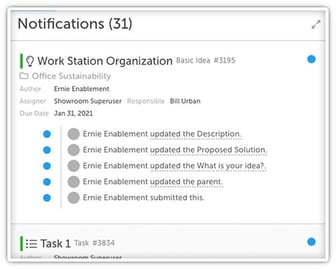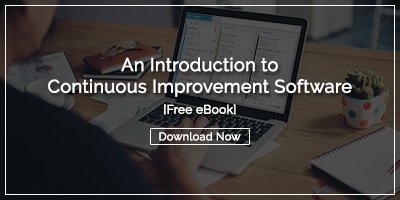-1.png?width=400&name=placeit%20(2)-1.png) Organizations that implement software designed to support, track, and align daily continuous improvement work gain big advantages over the competition. They can iterate faster, make smarter decisions, and engage more employees. If you are considering improvement software or trying to sell the idea to your team, this post is for you.
Organizations that implement software designed to support, track, and align daily continuous improvement work gain big advantages over the competition. They can iterate faster, make smarter decisions, and engage more employees. If you are considering improvement software or trying to sell the idea to your team, this post is for you.
Here are the major benefits that improvement software provides.
A Real-Time Improvement Dashboard
The continuous improvement paradigm is centered around daily, incremental changes. Most of the time, these projects don't require executive-level intervention. Issues with workspace organization, inefficient processes, or sloppy data entry aren't likely to land on the CEO's desk, but those are precisely the kinds of problems that can have a significant impact on critical metrics. With improvement management software in place, leaders get insight into how the team is addressing them. There is substantial value in knowing what types of opportunities are being identified, who is working to resolve them, and how quickly those improvements are made.
Goal Alignment
Many leaders go through a strategic planning exercise, developing a vision for where the organization will be in three to five years. To get there, everyone needs to be rowing in the same direction and working toward unified game-changing objectives. Quality improvement software sets up the structure for leaders to cascade goals from the high-level strategy down to the front line. Each employee has a clear understanding of how their work relates to the overall objectives, and those same goals drive performance evaluation. When everyone is aligned around the most critical missions, decision making is simplified, and improvement opportunities become more apparent.
Culture Becomes Manageable
Corporate culture is a tricky thing. Every organization has one, even if it isn't managed with intention. Many leaders strive to infuse the culture with improvement-centered thinking and the willingness to engage. It isn't easy because leaders can't dictate the culture. It is the aggregate of all of the clues people receive about what constitutes "normal" behavior. Improvement management software serves as a culture dashboard. Leaders can see which individuals, teams, and departments are embracing the work and effecting positive change. It also becomes clear where additional training, coaching, and encouragement are needed.
Commitment is Apparent
Most organizations have software in place to manage every other important aspect of the business. Sales is run on a CRM; the finance team uses an accounting system; there's probably multiple tools running HR. That's because these essential business functions must be well managed. Improvement work is equally as important. When organizations invest in technology, they send a clear signal to staff that this is not a fad or the week's management trend.
An investment in technology gives your team confidence that leaders are willing to put financial resources to work, helping individuals become successful at managing improvement projects.
Employee Recognition Becomes Second Nature
Continuous improvement asks people to step out of their comfort zone and look at problems and processes with new eyes. It's uncomfortable for many people, especially when the approach is fresh and the culture is still developing. The best way to underscore the benefits of daily improvement and to get people excited about the possibilities for personal development and career growth is to recognize the people who get engaged and take action.
You Can Enumerate the Impact of Improvement
Embracing continuous improvement is a game-changer. It will change the notions on which your organization operates and impact every team member's daily activities. That's why leaders must quantify the impact of improvement and show employees, investors, boards, and others that the effort has been worth it.
Improvement technology helps you quantify the result against your organization's most important performance indicators like expenses, customer satisfaction, quality scores, and revenue.
Everyone is On the Same Page
Email is okay as a platform for reminders, but it doesn't give people one place to go for real-time data. Spreadsheets work well for keeping lists, but they are passive and easily broken sources for information. Improvement management software is a better approach that gives everyone on the team one place to go for the latest updates. The whole team is on the same page because they are looking at the same information, not an email message or Excel file that may be out of date.
Improvement Happens Faster
Improvement software keeps supervisors informed about each project's progress so that they can coach staff and remove obstacles when needed. Everyone knows when a task is assigned or a due date is missed.
Meetings are More Efficient
It is common for meetings to involve a lot of wasted time. Why? Because without a clear plan and visual management of what should be discussed, they often devolve into a lengthy conversation about one issue or veer away from improvement work entirely. Too much time is wasted on status updates, and too little is centered on action items. Improvement software makes meetings more useful in several ways. Everyone can get informed about the current status of projects before the meeting because it is all documented on one platform. People can constructively participate from wherever they are because the information is all online. Facilitators can devote more meeting time to discussing challenges and next steps because the details are at everyone's fingertips.
The Repository of Knowledge Grows
Improvement software is a collection point for all information about opportunities for improvement and completed projects. Teams can learn from past activities and repeat what works and avoid prior mishaps. New employees quickly come up to speed, and important intelligence isn't lost when people change jobs or leave the company.
Change Management is Consistent
Often, people get excited about the idea of improvement and start making changes that they think will lead to better outcomes without a consistent process for change or proper documentation. That can lead to changes that hurt more than they help or improvement that is impossible to quantify. Improvement management software helps solve this by ensuring a consistent process for implementing change across the entire organization.
Every leader wants their organization to improve. We all want to cut costs, improve customer satisfaction, get more efficient, and find new ways of generating revenue. The difference between organizations that succeed at achieving these objectives and becoming better over time and those unable to sustain progress often comes down to the structure upon which improvement initiatives are built. That's why improvement software is a significant competitive advantage.

![[WEBINAR] Bottom-Up Improvement Software Demo](https://no-cache.hubspot.com/cta/default/326641/8545f357-84e1-47b2-81e0-f4fa0d3cd893.png)


Add a Comment